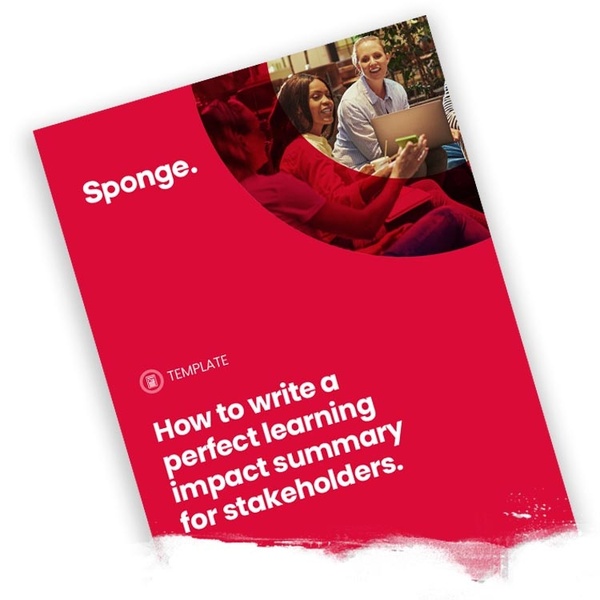Learning Analytics: Ihr Leitfaden für den Erfolg im Jahr 2022. (Engl.)

Learning Analytics ist nach wie vor ein heißes Thema. Sie gehört zu den fünf wichtigsten Prioritäten für L&D im Jahr 2022, und der Nachweis des Nutzens für die Stakeholder bleibt eine der größten Herausforderungen für L&D-Führungskräfte.
So, why is learning analytics still such a pressing topic?
In this guide, we’ll cover:
Download
Download our template: How to Write a Stakeholder Summary.
This guide is designed to be practical. We’re here to help you dust off any data anxiety and get up and running. Let’s go!

Why is learning analytics such a challenge in 2022?
To put it simply, many organisations have not yet reached data maturity when it comes to learning analytics. Across organisations we work with, we see that the appetite to gain actionable insights from data outstrips the ability, processes, and structures to do so.
If this sounds familiar, you may be at the early stages of the data maturity model. Watch our video on data maturity and take a look at the infographic to help you self-identify your position along the scale.
This year, the imperative for L&D teams to upskill in learning analytics, data analysis, and to invest in tech that can provide this clarity places a new demand on teams already juggling multiple HR priorities.
The global pandemic rapidly shifted focus to online learning and remote onboarding and placed heavier reliance on digital platforms, often causing L&D professionals mental and physical exhaustion.
Until L&D are using learning analytics to guide decision making, demonstrating their value to the organisation, and focusing their energies and budgets sharply on what matters, there’s no question the data topic will remain high on the agenda.
What L&D can do to progress with learning analytics.
What L&D needs, right now, is an accessible way to deal with data that lifts the burden from overstretched teams. Coupled with a deep desire to use data more effectively, we think 2022 is the year where L&D makes strong in-roads with learning analytics. Want to lead the charge? Here’s what you can do.
1. Take an honest benchmark of your data maturity
Key questions to ask include:
- Is the data we’re currently collecting reliable, timely, and in a comparable format across learning interventions? If the answer is no, you’re at ‘data aware’
- Does the data we are gathering serve to answer our performance hypotheses? For instance, ‘people who answer questions incorrectly have a performance blind-spot in this topic’. If the answer is no, you’re at ‘data proficient’
- Is the data we have helping us predict human capital risks we may face? If the answer is no, you’re at ‘data savvy’
- Is your data sophisticated at simulating possible scenarios to inform what you should do? If the answer is no, you’re at ‘data driven’
The important thing is to know that you are on a journey. It’s a positive step to identify the stage you’re at and recognise it will involve progression over months or even years, as you continually evolve your data comfort and capabilities.
2. Determine where you want to get to – and why
Let’s say you’re at ‘data aware’ like many L&D functions. You might take a laser-focus and commit to gaining reliable data in a comparable format that is relevant and timely. Or, if you’re at ‘data proficient’, you might seek to automate data processes that offer predictable insights into the performance hypotheses you’ve defined.
It can be helpful to define a ‘personal why’ and a ‘stakeholder why’. Perhaps your ‘personal why’ is that you need aggregated data to save time gathering and collating it from around the business or across vendors. Your ‘stakeholder why’ might be to gain increased clarity over a specific compliance risk.
3. Consider the skills and tech you already have in-house
Who is your go-to data person in the organisation? Are they in your team? If not, identify who you can discuss your learning analytics goals with. Decide whether you need help externally for advice, tech support, or data analysis services.
What platforms are you using to collect data? Do they serve your needs? It can be easy to feel limited or overwhelmed by the data that you have.
4. Think lean – roll out your MVP
Consider your next step of moving forward with analytics a bit like a lean product experiment. In light of your goals, the team, skills, and tech, you have identified at your disposal, craft your Minimum Viable Product.
We’ve seen clients use rudimentary tools to begin with to prototype their analytics. You may not require a large, or expensive intervention.
For example, one client at the ‘data aware’ stage wanted to see a snapshot of learning activity for a new, non-mandatory digital programme. To empower this, we created a weekly digest email that centralised metrics from a selection of sources such as their LMS, Zendesk, and Survey Monkey, to get them started with regular data monitoring.
5. Capture results and define your top 3 recommendations
Once you’ve got your experiment running, now it’s time to test its value. If your results are providing reliable descriptive analytics (i.e. a clear picture of ‘what happened’), you are now able to make recommendations.
It may be that you identified people are routinely getting a specific question incorrect. This leads you to suspect either that there is an issue with the question, or that there is a real-world lack of knowledge on this topic that could expose the company to risk. This informs a recommendation to investigate the cause further.
6. Overshare – get those results to stakeholders
Bringing stakeholders on the journey is an important part of demonstrating L&D value.
Most execs prefer a succinct summary of what the data has shown, what you plan to do next, and any associated request (budget, tech, resources etc.). Download our Stakeholder Summary template to get started. Take time pulling your story together and summarizing it, which might look something like this:
“We identified our data analytics capability at the ‘data proficient’ stage. Our goal was to move towards becoming ‘data savvy’, whereby we can start to predict risks faced by the organisation.
To do this, we put in place a pilot dashboard to examine learning analytics on a compliance onboarding. We identified that 20% of new recruits routinely answered questions about lone working incorrectly. As a result, we think this represents a risk.
Our next step is to interview learners to distinguish genuine knowledge gaps. We will fold any findings back into the onboarding training to close the knowledge gaps and reduce risk rate.
What we now need is a budget of X to expand this pilot to roll out across all compliance programs, to further identify and mitigate risks to employees and the business.”
Typical barriers to learning analytics and how to overcome them.
Several obstacles may be playing on your mind at this point. We know that barriers are a normal part of any endeavour, but we believe that the best way to overcome them is to expect them. That way, if they don’t crop up, your endeavour just got easier!
Here are some of the most common barriers we’ve seen L&D teams overcome when implementing learning analytics.
“Our whole company is lagging with data maturity; we don’t stand a chance at gaining investment in L&D”.
This is a familiar barrier, and one solution can be to lead the pack! If you trust in the value analytics can bring, go through the steps above, make your MVP and demonstrate your insights to stakeholders. Strategic learning partners like Sponge can also do some of this work for you, by showing examples of how L&D analytics have been implemented easily alongside a learning intervention – and enabled targeted spend the following year.
“We have so much data, we don’t know where to start”.
Our clients often find themselves in this situation. One way through this is to define your performance hypotheses that will determine what data you need and then cast the rest aside. This may also be critical for overcoming privacy and GDPR issues.
“The tools and tech for measuring data seem so complicated – I don’t have the time to learn yet another platform!”
We hear you. With so many competing priorities, learning new technologies and techniques can feel overwhelming. The key to this challenge is to consider what might be possible for We hear you. With so many competing priorities, learning new technologies and techniques can feel overwhelming.
The key to this challenge is to consider what might be possible for you right now. Perhaps all you need is one clean piece of data to answer one question, routinely.
Otherwise, you might explore hiring a partner that can produce a lightweight MVP and conduct and share the analysis, whilst you get to grips with it over time.
“We are stuck with SCORM! How can we get better insights from our existing courses?”
It can be easy for tech learning companies to say, ‘switch to xAPI’ or other standards that extract more meaningful measurements from your courseware. But many companies have a large library of legacy elearning content or assets (videos, blogs, social posts) that require attention.
In some cases, it may be possible to retroactively wrap legacy content with an xAPI layer that communicates with an LRS.
Alternatively, some clients choose to pick their top 20 most used digital experiences and have them converted to a new standard using xAPI and an LRS.
Others prefer to leave the courses as they are until the natural maintenance cycle offers the chance to update them (such as a compliance refresher, law change or language rollout).
And still others use the SCORM data as it is and complement it with other assets that are being tracked. This gets pulled into a dashboard to provide centralised descriptive analytics, providing enhanced visibility of what you already have.
How to embed learning analytics with confidence
Wherever you are in your learning analytics journey, we hope this guide has helped empower you to make tangible progress in 2022.
To recap:
- Assess your data maturity, with an honest lens
- Determine where you want to be, and why
- Identify internal and external skillsets you might need
- Think lean – roll out your data MVP
- Capture results and your top 3 recommendations
- Overshare your findings
And don’t forget, barriers are inevitable. By adopting the tactics we’ve seen other organisations use, you’ll be winning in no time.
We’d love to know how you get on, and we’re here to offer a friendly helping hand along the way if you need us.